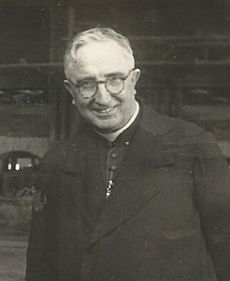Marcelino Olaechea facts for kids
Quick facts for kids Servant of God Marcelino Olaechea Loizaga |
|
|---|---|
| Archbishop Emeritus of Valencia | |
 |
|
| Church | Roman Catholic Church |
| Archdiocese | Valencia |
| See | Valencia |
| Appointed | 17 February 1946 |
| Reign ended | 19 November 1966 |
| Predecessor | Prudencio Melo Alcalde |
| Successor | José María García Lahiguera |
| Other posts |
|
| Orders | |
| Ordination | 20 December 1915 |
| Consecration | 27 October 1935 by Federico Tedeschini |
| Personal details | |
| Born | 9 January 1888 Baracaldo, Biscay, Spain |
| Died | 21 October 1972 (aged 84) Valencia, Spain |
| Nationality | Spanish |
| Sainthood | |
| Venerated in | Roman Catholic Church |
| Title as Saint | Servant of God |
Marcelino Olaechea (Marcelino Olaechea Loizaga) was an important Spanish Catholic leader. He was born on January 9, 1889, in Baracaldo, Spain. He passed away on October 21, 1972, in Valencia, Spain.
Marcelino Olaechea became a priest and joined the Salesians of Don Bosco. This is a religious group focused on educating young people. His father worked in the iron industry. Because of this, Marcelino's special symbol as a bishop, called a coat of arms, showed a factory chimney. This was instead of the usual lions or eagles.
He became an important leader within the Salesian group. On August 25, 1935, he was chosen to be the Bishop of Pamplona. He officially became a bishop on October 27 in Madrid. This ceremony was led by Federico Tedeschini, who represented the Pope. Marcelino Olaechea was the first Salesian priest in Spain to become a bishop. Later, on February 18, 1946, he became the Archbishop of Valencia.
Contents
Marcelino Olaechea During the Spanish Civil War
The Spanish Civil War was a difficult time in Spain (1936-1939). Marcelino Olaechea was the Bishop of Pamplona during this conflict. He worked to keep order among priests who helped soldiers. These priests were known as military chaplains. He set many rules to make sure they followed church discipline.
No More Blood! Sermon
One of Marcelino Olaechea's most famous actions during the war was a speech he gave. On November 15, 1936, he gave a sermon called No mas sangre, which means No More Blood! He gave this speech at an event for a Catholic women's group.
In his sermon, Bishop Olaechea spoke out against unfair killings. Sometimes, when a soldier died in battle, people in his town would quickly execute others. These killings happened without any proper trial. He wanted to stop these violent acts.
In towns and villages, people often knew who supported which political group. If someone was known to be a leftist, they were in danger. This was especially true when a funeral for a soldier was announced. Even if someone rarely went to church, they could be at risk.
Bishop Olaechea noticed that many people were coming to church out of fear. He said, "they bring fear with them as well, piercing the soul like a dagger." He believed the church needed to win people over with true faith and love. He also spoke about the importance of social justice and charity. During the war, a person's life could depend on what a local priest said about their church attendance. In some places, simply not going to Mass before the war could lead to someone being shot.
Images for kids
See also



